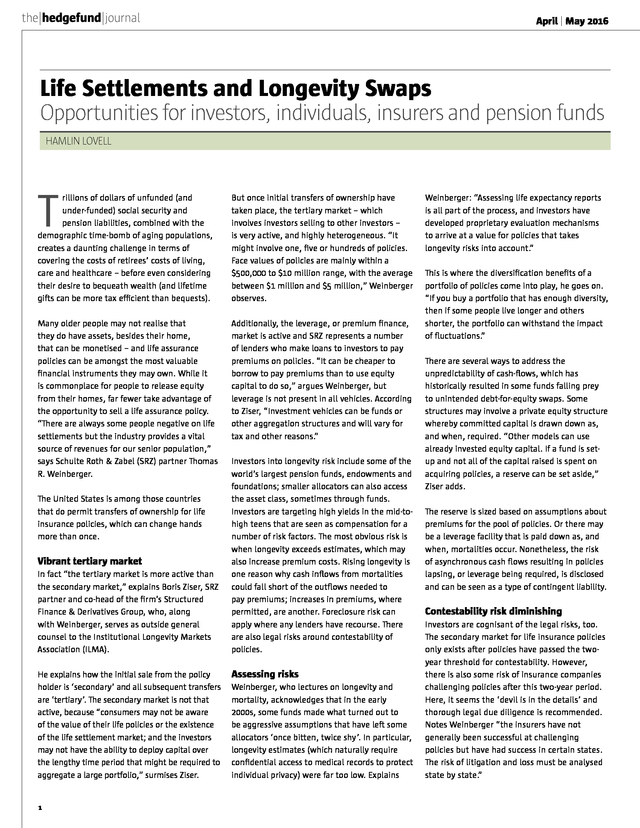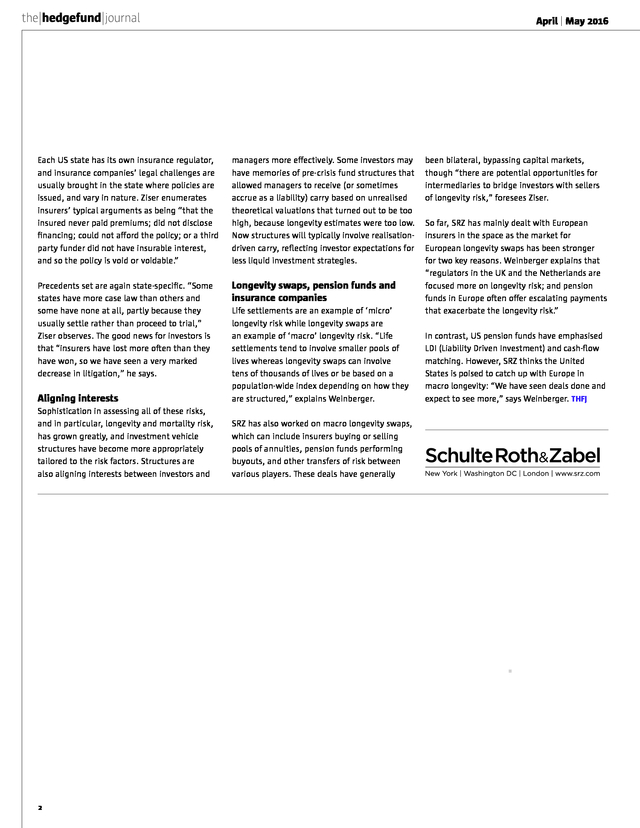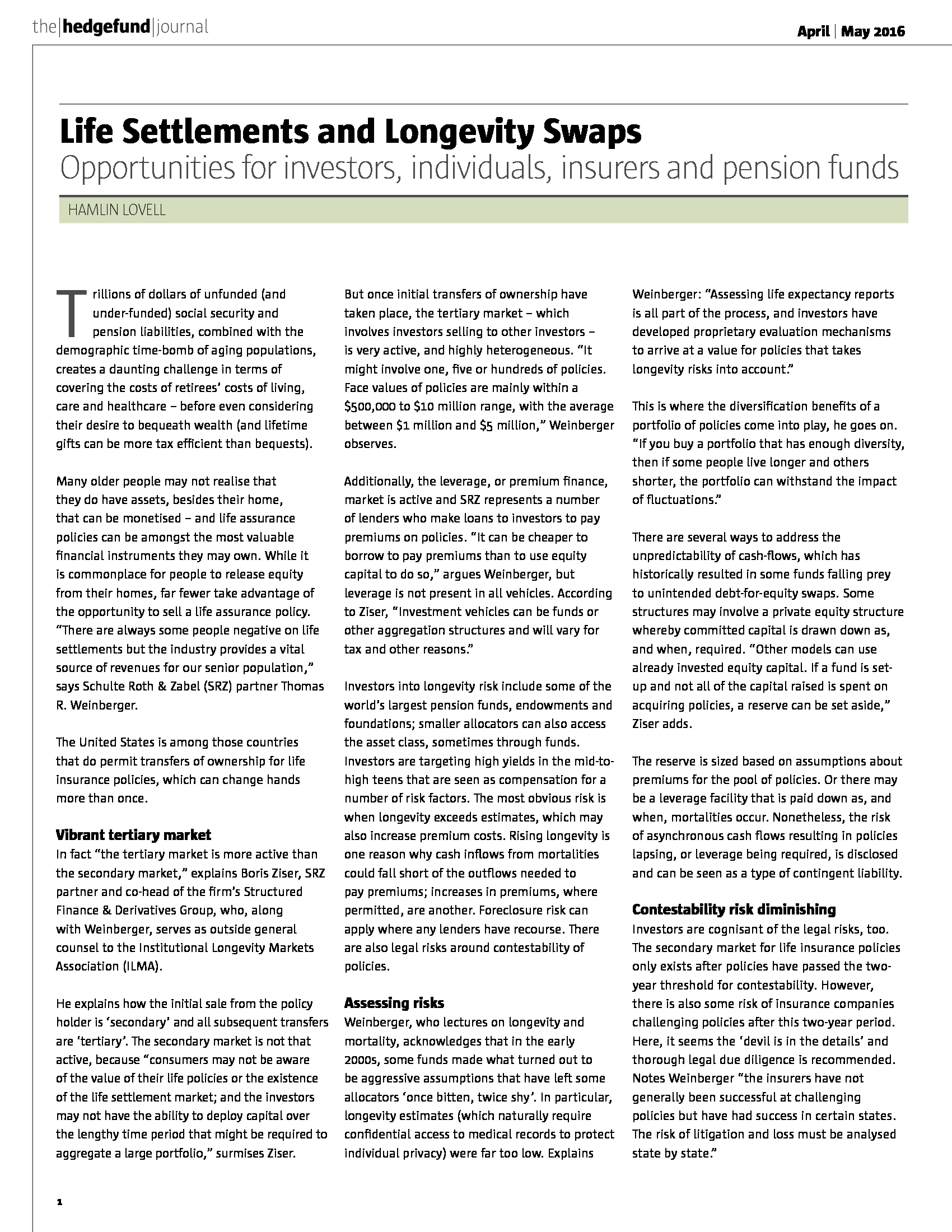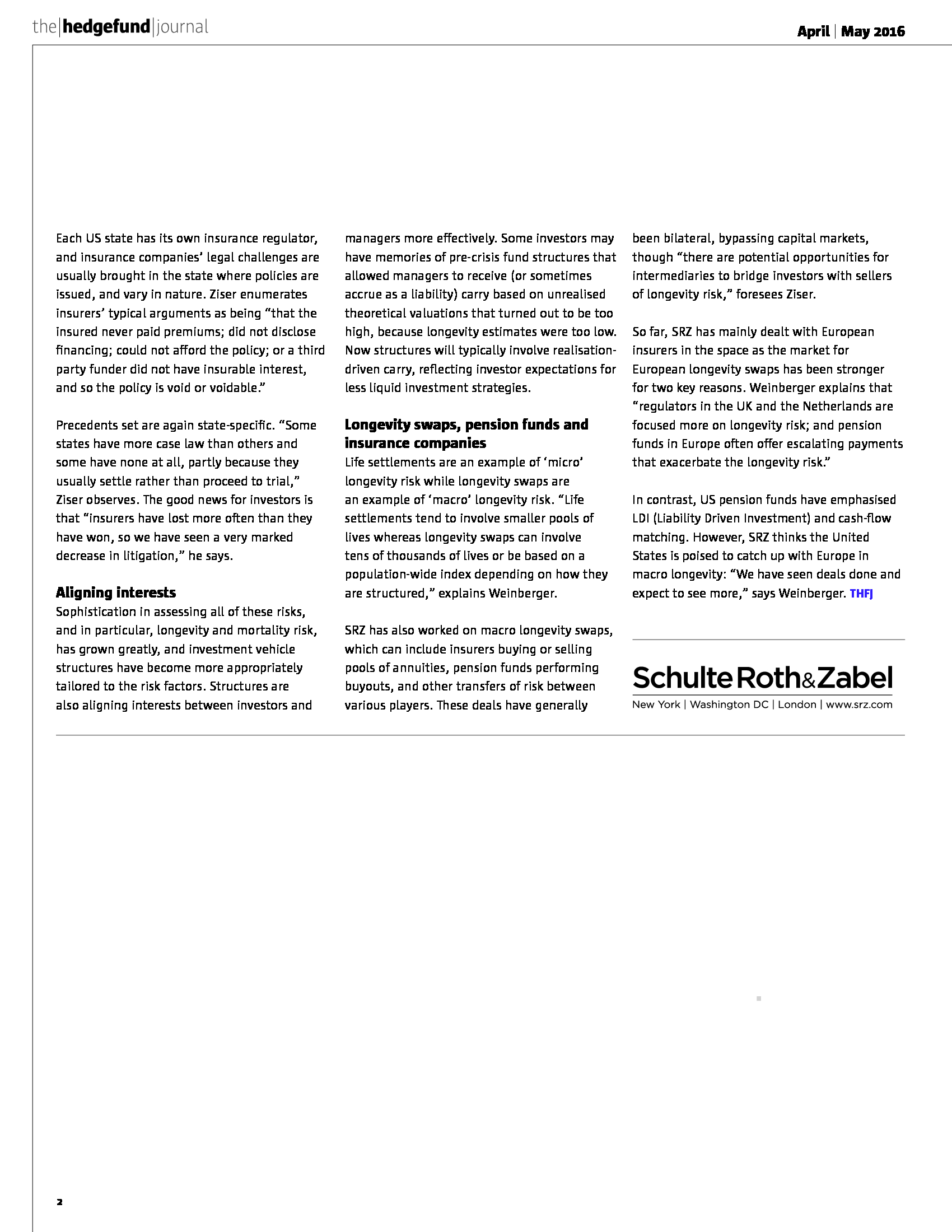Life Settlements and Longevity Swaps - Opportunities for investors, individuals, insurers and pension funds – April / May 2016
Schulte Roth & Zabel
Description
April | May 2016
Life Settlements and Longevity Swaps
Opportunities for investors, individuals, insurers and pension funds
HAMLIN LOVELL
T
rillions of dollars of unfunded (and
under-funded) social security and
pension liabilities, combined with the
demographic time-bomb of aging populations,
creates a daunting challenge in terms of
covering the costs of retirees’ costs of living,
care and healthcare – before even considering
their desire to bequeath wealth (and lifetime
gifts can be more tax efficient than bequests).
But once initial transfers of ownership have
taken place, the tertiary market – which
involves investors selling to other investors –
is very active, and highly heterogeneous. “It
might involve one, five or hundreds of policies.
Face values of policies are mainly within a
$500,000 to $10 million range, with the average
between $1 million and $5 million,” Weinberger
observes.
Many older people may not realise that
they do have assets, besides their home,
that can be monetised – and life assurance
policies can be amongst the most valuable
financial instruments they may own. While it
is commonplace for people to release equity
from their homes, far fewer take advantage of
the opportunity to sell a life assurance policy.
“There are always some people negative on life
settlements but the industry provides a vital
source of revenues for our senior population,”
says Schulte Roth & Zabel (SRZ) partner Thomas
R. Weinberger.
Additionally, the leverage, or premium finance,
market is active and SRZ represents a number
of lenders who make loans to investors to pay
premiums on policies.
“It can be cheaper to borrow to pay premiums than to use equity capital to do so,” argues Weinberger, but leverage is not present in all vehicles. According to Ziser, “Investment vehicles can be funds or other aggregation structures and will vary for tax and other reasons.” The United States is among those countries that do permit transfers of ownership for life insurance policies, which can change hands more than once. Vibrant tertiary market In fact “the tertiary market is more active than the secondary market,” explains Boris Ziser, SRZ partner and co-head of the firm’s Structured Finance & Derivatives Group, who, along with Weinberger, serves as outside general counsel to the Institutional Longevity Markets Association (ILMA). He explains how the initial sale from the policy holder is ‘secondary’ and all subsequent transfers are ‘tertiary’. The secondary market is not that active, because “consumers may not be aware of the value of their life policies or the existence of the life settlement market; and the investors may not have the ability to deploy capital over the lengthy time period that might be required to aggregate a large portfolio,” surmises Ziser. 1 Investors into longevity risk include some of the world’s largest pension funds, endowments and foundations; smaller allocators can also access the asset class, sometimes through funds. Investors are targeting high yields in the mid-tohigh teens that are seen as compensation for a number of risk factors.
The most obvious risk is when longevity exceeds estimates, which may also increase premium costs. Rising longevity is one reason why cash inflows from mortalities could fall short of the outflows needed to pay premiums; increases in premiums, where permitted, are another. Foreclosure risk can apply where any lenders have recourse.
There are also legal risks around contestability of policies. Assessing risks Weinberger, who lectures on longevity and mortality, acknowledges that in the early 2000s, some funds made what turned out to be aggressive assumptions that have left some allocators ‘once bitten, twice shy’. In particular, longevity estimates (which naturally require confidential access to medical records to protect individual privacy) were far too low. Explains Weinberger: “Assessing life expectancy reports is all part of the process, and investors have developed proprietary evaluation mechanisms to arrive at a value for policies that takes longevity risks into account.” This is where the diversification benefits of a portfolio of policies come into play, he goes on. “If you buy a portfolio that has enough diversity, then if some people live longer and others shorter, the portfolio can withstand the impact of fluctuations.” There are several ways to address the unpredictability of cash-flows, which has historically resulted in some funds falling prey to unintended debt-for-equity swaps.
Some structures may involve a private equity structure whereby committed capital is drawn down as, and when, required. “Other models can use already invested equity capital. If a fund is setup and not all of the capital raised is spent on acquiring policies, a reserve can be set aside,” Ziser adds. The reserve is sized based on assumptions about premiums for the pool of policies.
Or there may be a leverage facility that is paid down as, and when, mortalities occur. Nonetheless, the risk of asynchronous cash flows resulting in policies lapsing, or leverage being required, is disclosed and can be seen as a type of contingent liability. Contestability risk diminishing Investors are cognisant of the legal risks, too. The secondary market for life insurance policies only exists after policies have passed the twoyear threshold for contestability. However, there is also some risk of insurance companies challenging policies after this two-year period. Here, it seems the ‘devil is in the details’ and thorough legal due diligence is recommended. Notes Weinberger “the insurers have not generally been successful at challenging policies but have had success in certain states. The risk of litigation and loss must be analysed state by state.” .
April | May 2016 March 2016 Each US state has its own insurance regulator, and insurance companies’ legal challenges are usually brought in the state where policies are issued, and vary in nature. Ziser enumerates insurers’ typical arguments as being “that the insured never paid premiums; did not disclose everyone else’s afford so policy; does not financing; could notprofits, theBreslowor a third expect to see a tail of insurable interest, party funder did not have more than 5-10%. andValuation is rarely anor voidable.” so the policy is void explicit requirement for typical transfers of ownership around succession. “These transactions are not Precedents set are again state-specific. “Some structured in case law way others and states have more the same than as selling minority or controlling interests to seed some have none at all, partly because they or strategic rather than proceed to trial,” usually settleinvestors,” Breslow reveals.
Rather, “a sunset provision lets the key person Ziser observes. The good news for investors is continue to share in profits on declining that “insurers have lost more oftenathan they basis, so in have seen a very ‘sunsetted’ have won,andwe this way they get marked out of the business,” explains decrease in litigation,” he says. Breslow.
This may imply some probabilistic value on what is a kind of declining Aligning interests variable annuity, but there is no need to carry out a valuation Sophistication in assessing all of these risks, andexercise. in particular, longevity and mortality risk, has grown greatly, and investment vehicle One reason become more appropriately structures havefor this deal structure is optimising risk factors. Structures are tailored to the tax efficiency for the continuing alsoemployees. Explains Nissenbaum, “Though aligning interests between investors and 2 managers more effectively.
Some investors may have memories of pre-crisis fund structures that allowed managers to receive (or sometimes accrue as a liability) carry based on unrealised theoretical valuations that turned out to be too high, because longevity estimates were too low. a one-off sale will typically involve realisationNow structures of retirees’ ownership could be advantageous for investor expectations driven carry, reflectingtheir estate, because for profits would incur capital gains less liquid investment strategies. tax at lower rates than income tax, if the new owners made an outright purchase of interests in Longevity swaps, pension funds and the business, the consideration would not insurance companies be tax deductible an would be viewed as Life settlements areas itexample of ‘micro’ like an investment in public swaps are longevity risk while longevity equity.” SRZ also has specialist teams longevity risk. “Life an example of ‘macro’of industry-leading tax lawyers who will advise on these pools of settlements tend to involve smallermatters parallel to the fund formation team. lives whereas longevity swaps can involve tens of thousands of lives or be based on a Centenarian index depending on how they population-wide managers? Though both emergency and longer-term are structured,” explains Weinberger. succession plans should be in place, in some also they may macro longevity swaps, SRZ hascases worked onnot be actioned for many years or even decades.
The absence which can include insurers buying or selling of a of annuities, pension funds performing pools mandatory retirement age in the United and other transfers of risk between buyouts, States – combined with the energy, stamina and good health of some people various players. These deals have generally been bilateral, bypassing capital markets, though “there are potential opportunities for intermediaries to bridge investors with sellers of longevity risk,” foresees Ziser. So far, SRZ has mainly dealt with European working in finance – means that a number insurers the space as the market for of septuagenarian and even octogenarian European longevity swaps has been stronger hedge fund managers are still going strong. for two key reasons. Weinberger explains that The number in the UK and theand centenarian “regulators of nonagenarian Netherlands are money managers longevity risk; grow. focused more on seems sure to and pension Studies including some from the Brookings funds in Europe often offer escalating payments Institute show higher income groups in the that exacerbate the longevity risk.” US are extending their lifespans every year. At the other US pensionage spectrum, many In contrast, end of the funds have emphasised successful hedge fund managersand cash-flow LDI (Liability Driven Investment) could afford to retire almost any time thinks the United to matching.
However, SRZ and some choose do so in their 40s, making itwith Europe in States is poised to catch up a more urgent matter.longevity: “We have seen deals done and macro THFJ expect to see more,” says Weinberger. THFJ .
“It can be cheaper to borrow to pay premiums than to use equity capital to do so,” argues Weinberger, but leverage is not present in all vehicles. According to Ziser, “Investment vehicles can be funds or other aggregation structures and will vary for tax and other reasons.” The United States is among those countries that do permit transfers of ownership for life insurance policies, which can change hands more than once. Vibrant tertiary market In fact “the tertiary market is more active than the secondary market,” explains Boris Ziser, SRZ partner and co-head of the firm’s Structured Finance & Derivatives Group, who, along with Weinberger, serves as outside general counsel to the Institutional Longevity Markets Association (ILMA). He explains how the initial sale from the policy holder is ‘secondary’ and all subsequent transfers are ‘tertiary’. The secondary market is not that active, because “consumers may not be aware of the value of their life policies or the existence of the life settlement market; and the investors may not have the ability to deploy capital over the lengthy time period that might be required to aggregate a large portfolio,” surmises Ziser. 1 Investors into longevity risk include some of the world’s largest pension funds, endowments and foundations; smaller allocators can also access the asset class, sometimes through funds. Investors are targeting high yields in the mid-tohigh teens that are seen as compensation for a number of risk factors.
The most obvious risk is when longevity exceeds estimates, which may also increase premium costs. Rising longevity is one reason why cash inflows from mortalities could fall short of the outflows needed to pay premiums; increases in premiums, where permitted, are another. Foreclosure risk can apply where any lenders have recourse.
There are also legal risks around contestability of policies. Assessing risks Weinberger, who lectures on longevity and mortality, acknowledges that in the early 2000s, some funds made what turned out to be aggressive assumptions that have left some allocators ‘once bitten, twice shy’. In particular, longevity estimates (which naturally require confidential access to medical records to protect individual privacy) were far too low. Explains Weinberger: “Assessing life expectancy reports is all part of the process, and investors have developed proprietary evaluation mechanisms to arrive at a value for policies that takes longevity risks into account.” This is where the diversification benefits of a portfolio of policies come into play, he goes on. “If you buy a portfolio that has enough diversity, then if some people live longer and others shorter, the portfolio can withstand the impact of fluctuations.” There are several ways to address the unpredictability of cash-flows, which has historically resulted in some funds falling prey to unintended debt-for-equity swaps.
Some structures may involve a private equity structure whereby committed capital is drawn down as, and when, required. “Other models can use already invested equity capital. If a fund is setup and not all of the capital raised is spent on acquiring policies, a reserve can be set aside,” Ziser adds. The reserve is sized based on assumptions about premiums for the pool of policies.
Or there may be a leverage facility that is paid down as, and when, mortalities occur. Nonetheless, the risk of asynchronous cash flows resulting in policies lapsing, or leverage being required, is disclosed and can be seen as a type of contingent liability. Contestability risk diminishing Investors are cognisant of the legal risks, too. The secondary market for life insurance policies only exists after policies have passed the twoyear threshold for contestability. However, there is also some risk of insurance companies challenging policies after this two-year period. Here, it seems the ‘devil is in the details’ and thorough legal due diligence is recommended. Notes Weinberger “the insurers have not generally been successful at challenging policies but have had success in certain states. The risk of litigation and loss must be analysed state by state.” .
April | May 2016 March 2016 Each US state has its own insurance regulator, and insurance companies’ legal challenges are usually brought in the state where policies are issued, and vary in nature. Ziser enumerates insurers’ typical arguments as being “that the insured never paid premiums; did not disclose everyone else’s afford so policy; does not financing; could notprofits, theBreslowor a third expect to see a tail of insurable interest, party funder did not have more than 5-10%. andValuation is rarely anor voidable.” so the policy is void explicit requirement for typical transfers of ownership around succession. “These transactions are not Precedents set are again state-specific. “Some structured in case law way others and states have more the same than as selling minority or controlling interests to seed some have none at all, partly because they or strategic rather than proceed to trial,” usually settleinvestors,” Breslow reveals.
Rather, “a sunset provision lets the key person Ziser observes. The good news for investors is continue to share in profits on declining that “insurers have lost more oftenathan they basis, so in have seen a very ‘sunsetted’ have won,andwe this way they get marked out of the business,” explains decrease in litigation,” he says. Breslow.
This may imply some probabilistic value on what is a kind of declining Aligning interests variable annuity, but there is no need to carry out a valuation Sophistication in assessing all of these risks, andexercise. in particular, longevity and mortality risk, has grown greatly, and investment vehicle One reason become more appropriately structures havefor this deal structure is optimising risk factors. Structures are tailored to the tax efficiency for the continuing alsoemployees. Explains Nissenbaum, “Though aligning interests between investors and 2 managers more effectively.
Some investors may have memories of pre-crisis fund structures that allowed managers to receive (or sometimes accrue as a liability) carry based on unrealised theoretical valuations that turned out to be too high, because longevity estimates were too low. a one-off sale will typically involve realisationNow structures of retirees’ ownership could be advantageous for investor expectations driven carry, reflectingtheir estate, because for profits would incur capital gains less liquid investment strategies. tax at lower rates than income tax, if the new owners made an outright purchase of interests in Longevity swaps, pension funds and the business, the consideration would not insurance companies be tax deductible an would be viewed as Life settlements areas itexample of ‘micro’ like an investment in public swaps are longevity risk while longevity equity.” SRZ also has specialist teams longevity risk. “Life an example of ‘macro’of industry-leading tax lawyers who will advise on these pools of settlements tend to involve smallermatters parallel to the fund formation team. lives whereas longevity swaps can involve tens of thousands of lives or be based on a Centenarian index depending on how they population-wide managers? Though both emergency and longer-term are structured,” explains Weinberger. succession plans should be in place, in some also they may macro longevity swaps, SRZ hascases worked onnot be actioned for many years or even decades.
The absence which can include insurers buying or selling of a of annuities, pension funds performing pools mandatory retirement age in the United and other transfers of risk between buyouts, States – combined with the energy, stamina and good health of some people various players. These deals have generally been bilateral, bypassing capital markets, though “there are potential opportunities for intermediaries to bridge investors with sellers of longevity risk,” foresees Ziser. So far, SRZ has mainly dealt with European working in finance – means that a number insurers the space as the market for of septuagenarian and even octogenarian European longevity swaps has been stronger hedge fund managers are still going strong. for two key reasons. Weinberger explains that The number in the UK and theand centenarian “regulators of nonagenarian Netherlands are money managers longevity risk; grow. focused more on seems sure to and pension Studies including some from the Brookings funds in Europe often offer escalating payments Institute show higher income groups in the that exacerbate the longevity risk.” US are extending their lifespans every year. At the other US pensionage spectrum, many In contrast, end of the funds have emphasised successful hedge fund managersand cash-flow LDI (Liability Driven Investment) could afford to retire almost any time thinks the United to matching.
However, SRZ and some choose do so in their 40s, making itwith Europe in States is poised to catch up a more urgent matter.longevity: “We have seen deals done and macro THFJ expect to see more,” says Weinberger. THFJ .
Schulte Roth & Zabel















